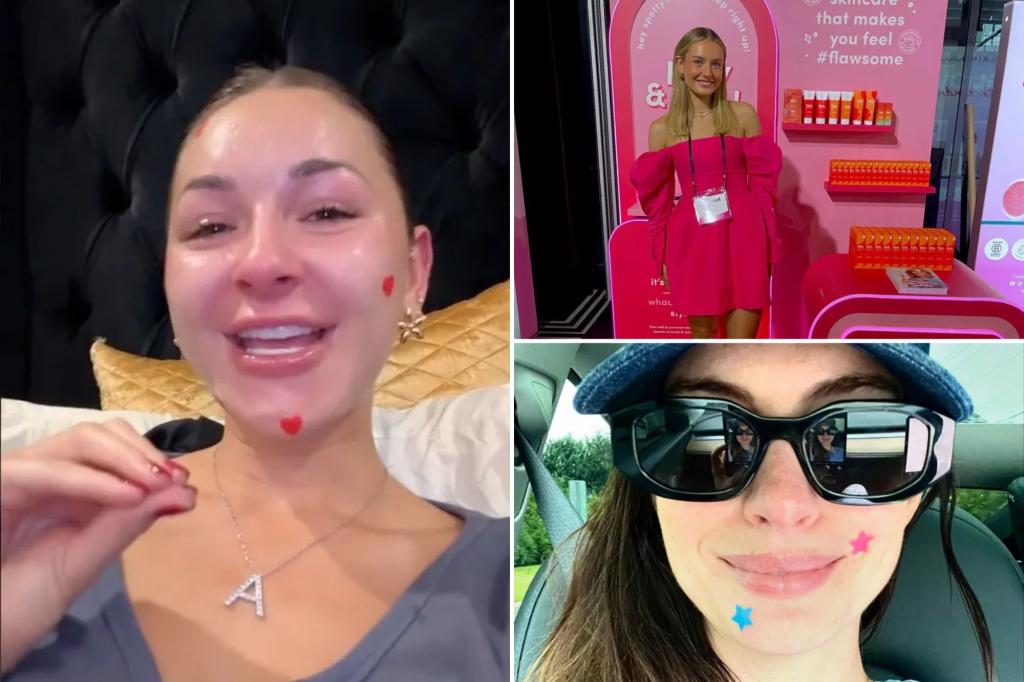The trend of wearing pimple patches as a fashionable accessory is gaining popularity among Gen Z, as seen when Australian influencer Anna Paul confidently sported heart-shaped stickers on her face at the Sydney airport. Paul, who recently launched her own beauty brand, Paullie Skin, has been known to promote acne treatments on her social media channels. This display of pimple patches on a high-profile individual like Paul is a refreshing change from the stigma associated with acne and highlights the struggles faced by those with problematic skin. Rachael Wilde, co-founder of Aussie brand TBH Skincare, praised Paul’s bold choice to wear the patches in public, emphasizing the importance of normalizing acne and promoting positive conversations about skincare.
Acne has historically been viewed as a condition that people feel the need to hide, but the trend of wearing decorative pimple patches is challenging this narrative. By showcasing acne treatments as fashion accessories, influencers like Anna Paul are helping to destigmatize acne and encourage open discussions about skincare. Rachael Wilde believes that the visibility of high-profile figures proudly wearing pimple patches can have a positive impact on young people dealing with acne-related mental health issues, such as depression and anxiety. The shift towards celebrating imperfections and embracing acne as a normal part of life is reflected in the increasing availability and popularity of pimple patches.
The traditional perception of acne treatment as clinical and stigmatizing is being challenged by the rise of decorative pimple patches as a trendy accessory. Brands like TBH Skincare are introducing pimple patches with playful designs, promoting the message of embracing imperfections and normalizing breakouts. The increasing variety of pimple patch options, including collaborations with sports teams and celebrities, reflects a growing acceptance of acne as a common and manageable skin condition. By incorporating fun and stylish elements into acne treatment, brands are reshaping the conversation around skincare from one of shame and negativity to one of confidence and self-expression.
Anna Paul’s choice to wear pimple patches in public has been met with praise from fans who appreciate her openness and relatability regarding acne. The positive response to Paul’s visible acne treatment illustrates the impact of influencers in shifting societal attitudes towards skincare and beauty standards. By sharing her own struggles with acne and showcasing treatments on social media, Paul is empowering others to feel confident and unashamed of their own skin imperfections. The visibility of celebrities like Hailey and Justin Bieber, Kim Kardashian, and Kid Laroi wearing pimple patches further normalizes acne treatment and encourages self-acceptance.
The growing trend of wearing pimple patches as a fashion statement has led to an expansion in the types and styles of available products. Medicated with ingredients like hydrocolloid or salicylic acid, pimple patches not only help clear acne but also provide protection against bacteria and reduce the urge to squeeze pimples. Collaborations between skincare brands and celebrities, as well as the introduction of themed pimple patches, reflect a broader cultural shift towards embracing imperfections and celebrating individuality. By promoting the message that acne is a common and natural part of life, these decorative pimple patches are reshaping societal perceptions of beauty and skincare.
Overall, the embrace of pimple patches as a trendy and fashionable accessory signifies a shift towards self-acceptance and openness about skincare struggles. Influencers like Anna Paul are leading the way in normalizing acne treatment and promoting positive conversations around skincare and beauty standards. By wearing pimple patches in public and sharing their experiences with acne, individuals like Paul are empowering others to feel confident and comfortable in their own skin. The increasing variety of pimple patch options and collaborations with high-profile figures demonstrate a changing attitude towards imperfections and a growing acceptance of acne as a natural aspect of life.


